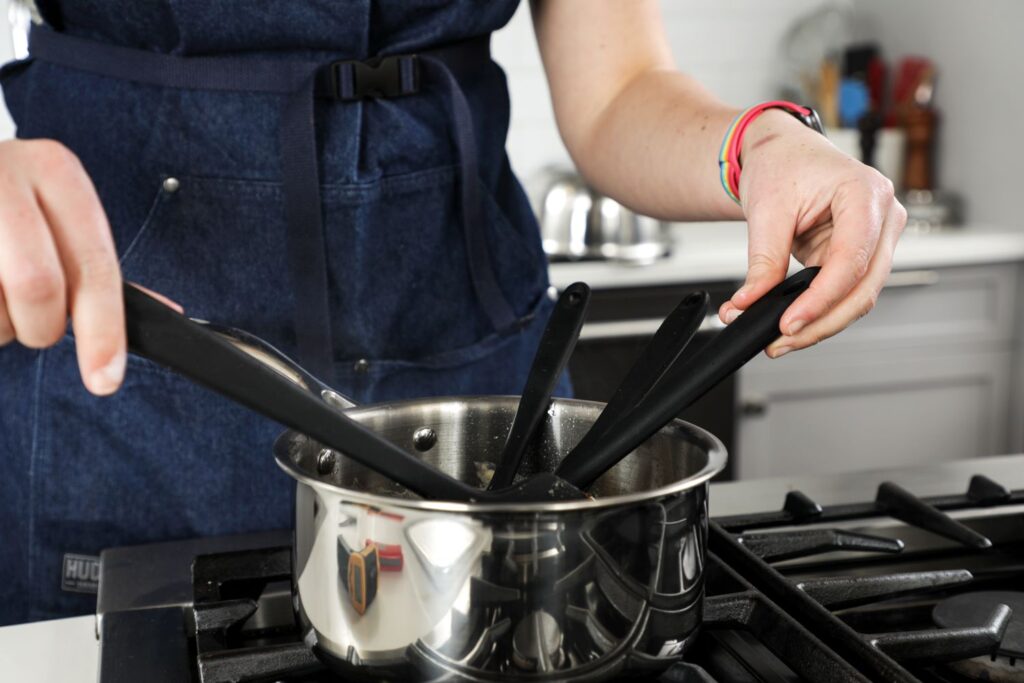In the world of kitchen gadgets, where air fryers and instant pots grab the headlines, it’s easy to overlook the humble tools that do the real day-in, day-out work. Tucked away in a utensil crock, often stained with turmeric or tomato sauce, lies a true culinary MVP: the silicone spatula.
This isn’t your grandmother’s rubber scraper (though it is its brilliant, modern evolution). The silicone spatula is a masterpiece of design, chemistry, and pure kitchen utility. It’s time we gave it the spotlight it deserves.
From Labs to Your Stovetop: The Magic of Silicone
So, what makes this tool so special? The secret is in the material. Food-grade silicone is a synthetic polymer, primarily made from silica (found in sand), which gives it a unique set of superpowers:
Heat Resistance: Unlike plastic that can melt or wooden spoons that can scorch, high-quality silicone can typically withstand temperatures from -40°F to 500°F (-40°C to 260°C). This means you can confidently scrape a searing pan of onions without leaving a melted mess behind. It’s oven-safe, microwave-safe, and dishwasher-safe.
Gentle Yet Firm: Silicone is soft and flexible enough to protect your expensive non-stick cookware from scratches but firm enough to scrape every last bit of cake batter from a bowl. This perfect balance saves your pans and prevents food waste—meaning more cookie dough for you.
Non-Stick and Non-Porous: Nothing sticks to silicone. It wipes clean with ease and its non-porous surface resists harboring odors and bacteria. That lingering smell of garlic that haunts wooden spoons? Not a problem here.
More Than Just a Scraper: The Many Hats of a Silicone Spatula
Its versatility is staggering. Think of it as the Swiss Army knife of kitchen utensils:
The Baker’s Best Friend: This is its classic role. Getting every atom of brownie batter, cheesecake filling, or whipped cream out of a mixing bowl is a deeply satisfying ritual made possible only by the flexible edge of a spatula.

The Sauté Savior: Folding delicate ingredients, gently scrambling eggs in a non-stick pan, or deglazing a pan to create a flavorful sauce—the spatula’s heat-resistant head is perfect for it all.
The Spreadable Force: Icing a cake, spreading mayonnaise on bread, or smoothing out a layer of hummus on a platter. Its flat, even surface is ideal for any spreading task.
The Cleaning Crew: That last bit of jam in the jar? The final drizzle of honey? The spatula is on the case, ensuring you get every bit of what you paid for.
Choosing Your Champion: Not All Spatulas Are Created Equal
With a plethora of options available, how do you choose the right one?
One-Piece Construction: Avoid heads that are glued or poorly attached to the handle. Spatulas with a seamless, one-piece design or a firmly embedded stainless steel core are more durable and hygienic, with no crevices for gunk to hide.
Quality of Silicone: Opt for 100% food-grade silicone. A good test is to pinch the head; high-quality silicone will leave no white mark or discoloration. Be wary of strong chemical smells, as this can indicate fillers or lower-grade materials.
The Right Shape: Spatulas come in a variety of head shapes—angled, straight, wide, narrow. An angled head is fantastic for getting into the corners of pots and pans, while a wider head is better for folding and spreading.
A Small Tool with a Big Impact
In the end, the silicone spatula embodies the principle that the best tools are those that solve problems simply and effectively. It protects our cookware, respects our ingredients, and makes cleaning up just a little bit easier.
So, the next time you reach for that colorful, flexible tool, take a moment to appreciate this small marvel of modern cooking. It may not be the flashiest item in your kitchen, but it’s undoubtedly one of the most reliable. It’s the silent partner in countless meals, a testament to the idea that sometimes, the simplest innovations make the biggest difference.

